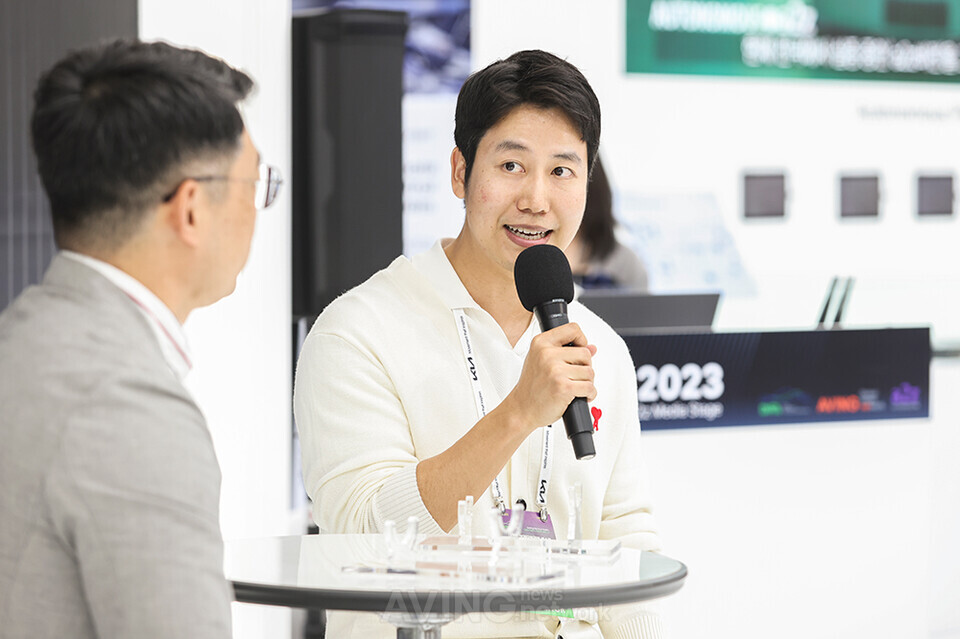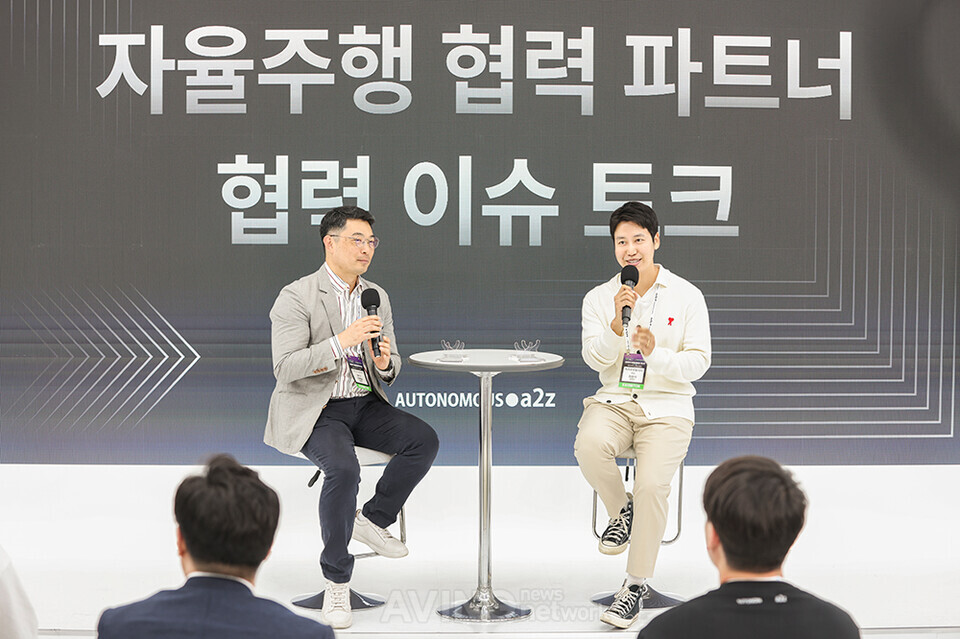Press “In the future, the multi-functional role of autonomous mobility services will be crucial," said Choe Won-seok, director of future business development at Kakao Mobility. “The MS-SD model of Auto…
페이지 정보
작성자 Autonomous a2z 조회 149 작성일 2023-11-07본문
Byungyong You (left), technical director of Autonomous a2z, and Choe Won-seok (right), director of future business development at Kakao Mobility, spoke during the "Autonomous Mobility Partner Cooperation Issue Talk" session at the Autonomous a2z booth in the 2023 DIFA on Friday, October 20th. | Photo by AVING NEWS
Autonomous a2z, an autonomous mobility company developing a driverless mobility platform, held a panel discussion with its autonomous mobility partner Kakao Mobility in the 2023 Daegu International Future Auto & Mobility Expo (DIFA) in Daegu EXCO on Friday, October 20th.
On the second day of the exhibition, Autonomous a2z hosted Choe Won-seok, director of future business development at Kakao Mobility, to discuss the current status and future of the company's commercialization of autonomous mobility technology. Byungyong You, technical director of Autonomous a2z, served as session facilitator.
Since December 2020, Autonomous a2z has been collaborating with Kakao Mobility to provide a “Demand Responsive Transit (DRT)” service. Autonomous a2z provided the autonomous driving solution, and Kakao Mobility provided the service platform.
The first service was implemented in a 4-kilometer section near the government building in Sejong Special Self-Governing City. The service works by reserving a ride through the KakaoT application, and the autonomous vehicle arrives at the call point, picks up the passengers, and takes them to their destination. In July of the following year, the service area was expanded to include a 50-kilometer section including Sejong Express Bus Terminal and Sejong City Hall.
Then, in November 2022, the company launched the self-driving mobility service “Dalgubeol Autonomous Vehicle Service” in Daegu, and in May this year, the integrated passenger and logistics service “Dalgubeol Autonomous Vehicle+ Service” was started. The two services in Daegu were also implemented in combination with Kakao Mobility service.
Before starting the conversation, Director Choe commented on the MS and SD of the Autonomous a2z, "If these vehicles had come out three years ago, we would be looking at a different future."
First, Director You asked about Kakao Mobility's plans when it launched the service with Autonomous a2z and the current results.

Choe Won-seok (right), director of future business development at Kakao Mobility, responds to questions during the October 20 “Autonomous Mobility Partner Cooperation Issue Talk” session at the Autonomous a2z booth in the 2023 DIFA | Photo by AVING NEWS
In response, Director Choe recalled that Kakao Mobility had two directions when it started its autonomous mobility business. It is about filling the gap in transportation service that current vehicles are unable to provide, and running such services efficiently.
In particular, we have found that public transportation, such as buses, is inefficient in places where there is no demand for it. Therefore, Kakao Mobility has developed a service that allows people who work in a specific location to request a ride and travel only when they need it.
“For example, buses traveling to and from private properties such as factories and university campuses, often referred to as ‘non-public roads,’ had efficiency problems, such as running a regular route even with few passengers on board,” says Director Choe. “It's hard to recruit drivers for these vehicles, and we wanted to reduce the number of these large vehicles and introduce an autonomous transportation service that only runs when there is demand," he added.
“For now, we’re focusing on enabling people to use autonomous mobility services to travel from their homes to transportation hubs such as subways and bus stops,” he said. “In the future, we’ll need a ‘multi-functional roles model’ of autonomous mobility services, where the services are optimally implemented in a combination of roles rather than just one. In that regard, my view is that MS and SD will be important pieces of the puzzle.”
According to Director Choe, the Dalgubeol Autonomous Vehicle Service is intended to be a taxi, while the Dalgubeol Autonomous Vehicle+ Service has been operating based on a network of stops. Currently, Kakao Mobility operates both platforms simultaneously to compare and understand the demand for each service.
Director You asked about the current number and utilization of Dalgubeol autonomous driving and plus service vehicles, and the implications of such services in Daegu in light of autonomous driving.
First, Director Choe said that the number of Dalgubeol autonomous vehicles used in the two services has increased from the initial three to five, emphasizing that it is the reutilization rate of the service that matters more than the number of vehicles.

Byungyong You (left), technical director of Autonomous a2z, and Choe Won-seok (right), director of future business development at Kakao Mobility, spoke during the “Autonomous Mobility Partner Cooperation Issue Talk” session at the Autonomous a2z booth in the 2023 DIFA on Friday, October 20th. | Photo by AVING NEWS
“The most important indicator of the effectiveness of the service is the number of cases an hour per vehicle," says Director Choe, "and the average is currently between 2.5 and 3.3 cases per vehicle. That's 3 calls an hour. This means that the utilization rate is similar or higher compared to regular taxis."
“We had two goals when we originally designed this service. We wanted to provide a service that was accessible to a large number of people, and one that was used repeatedly. We now believe that the 67% re-utilization rate shows that autonomous driving services are actively used in people's daily lives. Soon, we'll be able to do it through MS."
“Autonomous a2z is a company with great technology and the benefit of collaboration is reducing costs," said Director Choe. “In addition, autonomous mobility technology is a difficult service to adopt due to high development and operation costs. With the Autonomous a2z, however, all these problems are solved," he says with a smile.
Director You said, "Autonomous a2z had no intention to directly launch a vehicle. The idea was to develop Level 4 autonomous driving software and then retrofit existing vehicles to run the solution. But it was clear that there were no vehicles that could handle the software. That's what led us to develop our own autonomous vehicles."
He concludes, "In the future, we will produce more Level 4 vehicles and deploy them in transportation hubs such as apartment complexes and city centers, as well as in disadvantaged areas. We are aiming for full commercialization in 2025. We hope to launch services through MS and SD with Kakao Mobility, as well as pioneer new sales channels to enter the global stage."
Meanwhile, the 2023 DIFA, which has been held for the seventh time in Daegu since 2017, covered the entire mobility industry, including eco-friendly vehicles (electric and hydrogen), motorized parts such as motors, batteries, and chargers, autonomous driving, and urban air mobility (UAM) under the theme of From the ground to the sky, a new beginning of mobility. In particular, as the Ministry of Land, Infrastructure, and Transport and the Ministry of Trade, Industry, and Energy, the co-host Ministries, are the two main pillars of policy promotion in preparation for the era of full autonomous driving services and UAM commercialization through 2027-2030, the exhibition showcased the technological achievements supported by the policy focus and introduced the latest policy directions.


